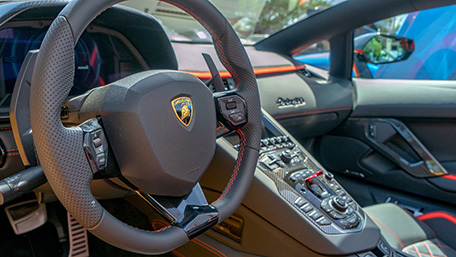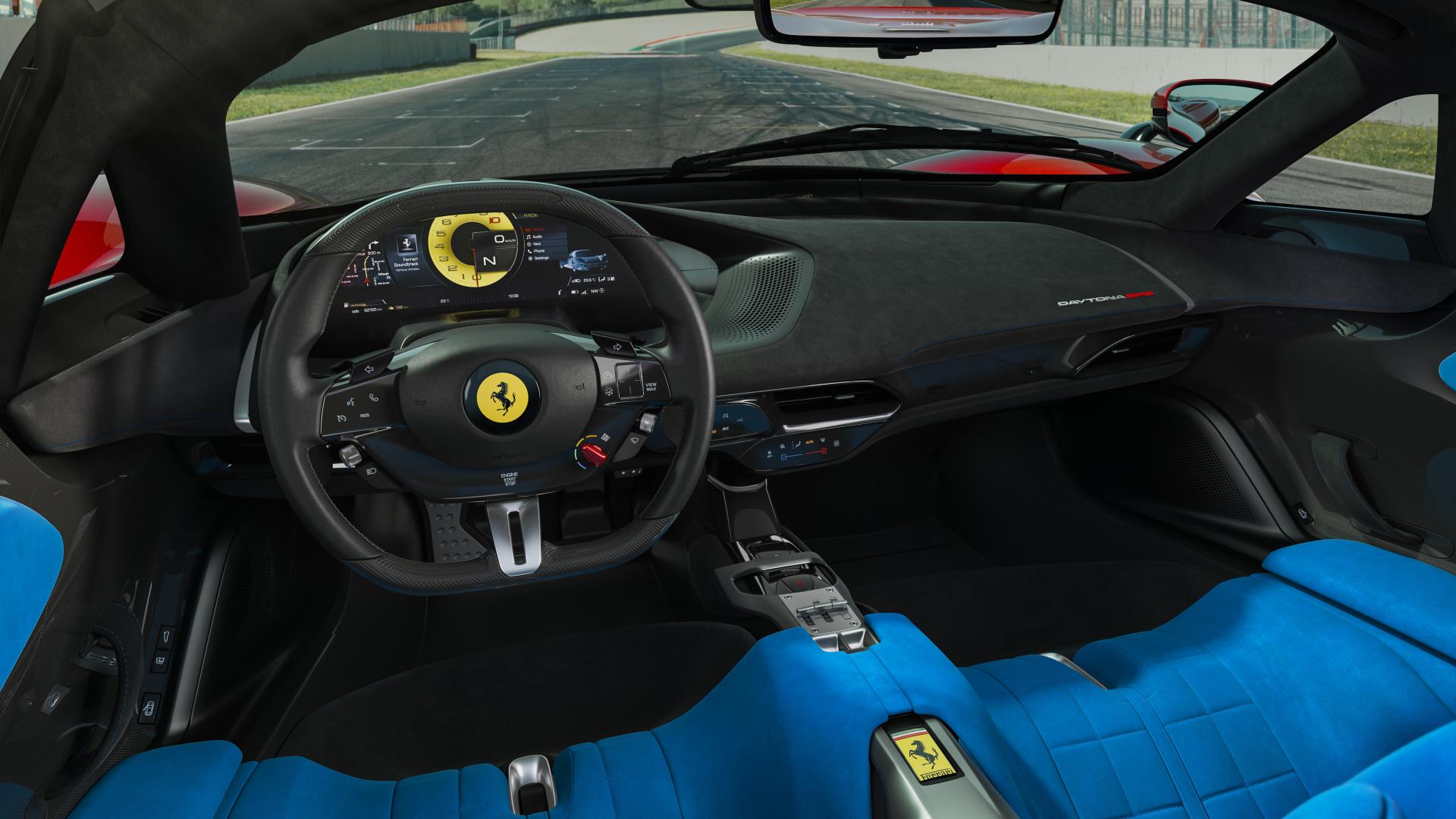It fires up the same way as the fixed-roof coupe, via a missile launcher-style shield hiding a small hexagonal Start button. With a firm press the starter whirs as fuel dumps into all 12 cylinders, igniting 6.5 liters of air and gasoline in a riot of internal combustion. But with its roof off, the $460,247 Lamborghini Aventador S Roadster stirs to life with an incrementally different auditory punch, a cascade of deep, raspy notes pours more clearly out of the enormous exhaust pipes and into the snug cabin.
Sound connoisseurs may notice the more mechanical whirs of valvetrain seeping into the cockpit, but we suspect the vast majority of Aventador S Roadster buyers are here for the sun – no doubt the reason Lamborghini organized this particular test-drive in Malibu, Calif. Our tester awaits with its twin carbon-fiber roof panels stowed in the nose, a rather convenient state because, as memory serves from our first-generation Aventador Roadster, the lid removal process requires a fairly awkward dance.
Climbing inside is a considerably easier task when this Lambo is opened up to the elements. There’s no head-ducking or awkward sliding, though once settled you will struggle for a place to stow your cell phone. Apart from the shallow glove box there are no other storage compartments, just a tiny USB/12-volt outlet beneath a flip-up lid that’s barely big enough to hold a key fob. At least a small concession to convenience comes in the form of a removable cupholder mounted on the passenger side of the center console.


When the massive V12 stirs to life, any concerns about practicality quickly fade away. The S Roadster gains the same improvements made to the S coupe, among them smoother suspension and improved aerodynamics (more downforce or less drag, depending on spoiler settings), the addition of four-wheel steering and a 38-horsepower gain, for a total of 729 hp. Also welcome is the ability to independently control suspension, steering and engine modes in what Lamborghini dubs the EGO setting.
That said, it’s all but impossible to ignore the human ego when rolling through town in an al fresco Lamborghini: The pointy two-seater cuts through traffic like a blade, leaving a wake of camera phone-wielding gawkers and swivel-necked onlookers fixated on its origami edges. But more crucially to those who care more about driving than posing, the updated Lambo delivers a palpably different left-seat experience compared with the first-gen Roadster.
Like the earlier model, structural reinforcements add 110 pounds to the curb weight and incur a one-tenth-of-a-second penalty in the 0-to-62-mph sprint, doing the deed in 3 seconds flat. Top speed remains unchanged at 217 mph. But in this case, the Aventador is better equipped to mask the extra mass thanks to the new four-wheel steering system, which has the effect of virtually shrinking or lengthening the wheelbase by 20 or 27 inches, respectively.

On the tight stretches of Mulholland Canyon, I can feel the tail swing sideways while turning in to each corner, making the car feel like it’s more willing to hustle its weight into the bend. In fact, the effect is sometimes so pronounced I need to delicately manage my steering inputs so the weight transfer isn’t too dramatic. Similarly, Sport and Corsa modes require careful throttle modulation because the effect is so direct: jam the gas, and you’ll lurch forward obtusely like a 15-year-old in driver’s ed. But while the Aventador still feels somewhat big-boned and lacks the overall agility of the Huracán (and especially the Huracán Performante), the four-wheel steering goes a long way toward making it feel smaller than it actually is. The effect also comes in handy when pulling u-turns, revealing a noticeably tighter turning radius.
When flinging the Aventador through canyons there’s some safeguard in the fact that the electronically controlled Haldex differential automatically adjusts the front/rear bias for optimal grip. It takes a bit of aggression, especially on warm weather days, to make the hulking 355-mm rear tires slip. Counterintuitively, the electronic stability control lets you get away with more shenanigans in Sport mode (which biases 90 percent of power distribution to the tail) as opposed to Corsa mode (which is tuned for optimal lap times and sends only 80 percent of power to the rear, making for fewer tail-happy slides but quicker, more efficient lines through corners).
We weren’t able to drive the Roadster with the hardtop in place, but our recollection of our track drive in the previous-gen model suggests a rock-solid chassis that enables a high amount of confidence. The Roadster felt stiff and responsive during our canyon drive, suggesting little or no perceptible compromise to the fixed-roof car.




Through all the enthusiastic canyon carving and moderate-to-high-speed cruising, the cabin remains a surprisingly turbulence-free space, largely thanks to the considerable distance between the seat bottom and the airflow above. A relatively still pocket of air can be preserved by keeping all three windows up, but lowering the rear window amplifies the sound of the sonorous V12. Also neat is the beveled top edge of the windows, which adds a jewelry-like feeling to the interior which can feel otherwise plasticky unless the optional carbon-fiber trim box is ticked. But as with the coupe, there’s a disconcerting lack of rear three-quarter visibility, which makes it particularly critical to mind the side mirrors (or just drive so fast there’s nobody behind you to hit when you change lanes).
The seven-speed automated single-clutch gearbox enjoys some refinements with the S iteration, but there’s still an inherent awkwardness to the shift action unless you’re near the roadster’s wailing 8,400-rpm redline. Trundle around in Strada mode, and the shifts are innocuously smooth, even leisurely. Things get crisper in Sport, but under moderate to mildly aggressive acceleration, there’s still a jerky pause before the next gear is engaged. Hammer the throttle, a perfectly normal thing to do on a racetrack (but cause for arrest on public roads), and the digital tach on the TFT quickly climbs as the titanium exhaust spits out an angry tune that gets interrupted by a brief staccato pop while the transmission jams into the next gear. As fun (and effective) as it may be to drive an Aventador S Roadster at that level, the spectacle and speed are simply untenable on public roads. Unfortunately, there’s no mellow middle ground, unlike in the Huracán, whose dual-clutch transmission is equally adept at low-speed loafing and high-speed frenetics.
The Lamborghini Aventador S Roadster is sharp, brash and more than a bit refined than its predecessor – but still an unapologetically imperfect beast thanks to its graceless gearbox and brutish manners. Yet in spite of its shortcomings, this strain of bull reminds of everything we love about mechanical charisma. The Huracán Performante may have all the right moves with its impeccable track manners and tightly contained dynamics, but the Aventador still reminds us of the days when supercars weren’t so tractable and obedient, but rather wild, snorting and more than a bit daunting to drive fast. As a rolling expression of excess, it’s hard not to fall for the open-air Aventador S’s naturally aspirated scream for attention.
Related Video:




